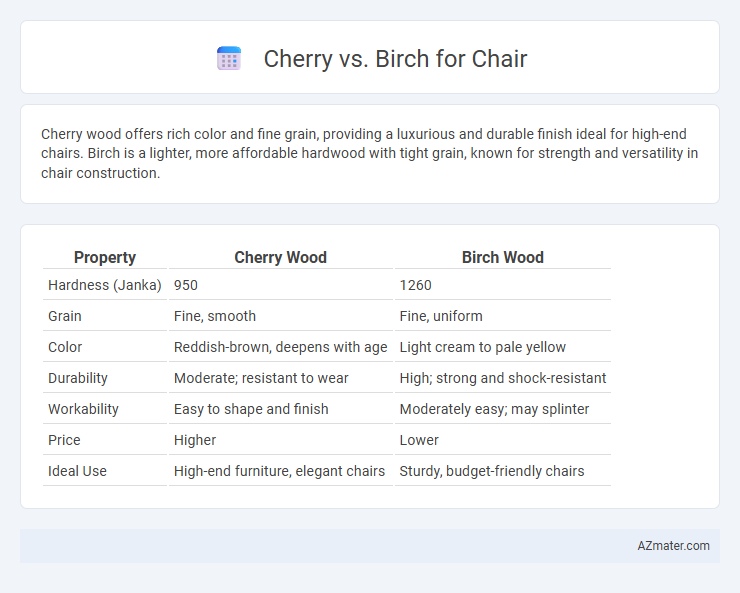Cherry wood offers rich color and fine grain, providing a luxurious and durable finish ideal for high-end chairs. Birch is a lighter, more affordable hardwood with tight grain, known for strength and versatility in chair construction.
Table of Comparison
| Property | Cherry Wood | Birch Wood |
|---|---|---|
| Hardness (Janka) | 950 | 1260 |
| Grain | Fine, smooth | Fine, uniform |
| Color | Reddish-brown, deepens with age | Light cream to pale yellow |
| Durability | Moderate; resistant to wear | High; strong and shock-resistant |
| Workability | Easy to shape and finish | Moderately easy; may splinter |
| Price | Higher | Lower |
| Ideal Use | High-end furniture, elegant chairs | Sturdy, budget-friendly chairs |
Introduction to Cherry and Birch Wood
Cherry wood, prized for its rich, reddish-brown hue and smooth grain, offers durability and a warm, elegant finish ideal for chair making. Birch wood features a lighter color with a fine, even texture that provides strength and resilience while maintaining an affordable price point. Both hardwoods are valued for their workability and ability to develop a beautiful patina over time, making them popular choices in furniture craftsmanship.
Key Characteristics of Cherry Wood
Cherry wood is prized for its rich reddish-brown color that deepens with age, offering a warm, elegant look ideal for chair construction. It features a fine, straight grain with a smooth texture, providing excellent workability and a refined finish. Durable yet moderately hard, cherry wood resists wear and dents, making it suitable for furniture subjected to daily use.
Key Characteristics of Birch Wood
Birch wood is known for its light color, fine grain, and exceptional strength, making it a durable option for chair construction. Its resistance to wear and moisture ensures longevity and maintains structural integrity in daily use. Compared to cherry, birch offers a more neutral, contemporary aesthetic that complements various interior styles.
Durability and Strength Comparison
Cherry wood offers excellent strength with moderate hardness, making it resilient to wear and ideal for chairs subjected to regular use. Birch wood ranks higher in hardness and density, providing superior durability and resistance to dents or scratches, which enhances its suitability for long-lasting furniture. Both woods exhibit good stability, but birch's increased toughness generally ensures greater longevity under frequent stress.
Appearance and Grain Differences
Cherry wood displays a rich, warm reddish-brown hue that deepens with age, offering a smooth, satiny finish ideal for elegant chair designs. Birch features a pale, creamy color with subtle yellow undertones and a uniform, fine grain pattern that creates a clean, modern look. Cherry's grain is typically straight with occasional waves, providing a dynamic texture, whereas birch has a more consistent and tight grain, emphasizing simplicity and durability in chair construction.
Workability and Ease of Crafting
Cherry wood offers excellent workability due to its fine, uniform grain and moderate hardness, making it easy to shape, sand, and finish for crafting chairs. Birch, known for its strong and dense composition, requires sharper tools and more effort to machine but provides a smooth surface and holds detailed carving well. Both woods are favored in chair-making, with Cherry preferred for quicker, more precise craftsmanship and Birch chosen for durability and intricate design elements.
Cost and Availability Analysis
Cherry wood typically commands higher prices due to its rich color and fine grain, which are highly valued in premium chair manufacturing. Birch offers a more cost-effective alternative, providing strong durability and a lighter finish, with greater availability in North American markets. The steady supply of birch ensures consistent pricing, whereas cherry prices can fluctuate due to limited regional harvests and longer maturation periods.
Finishing and Maintenance Needs
Cherry wood offers a warm, rich finish that deepens over time with exposure to light, providing a natural patina ideal for elegant chairs. Birch features a lighter, more uniform grain that takes stains evenly, allowing for versatile finishing options but may require more frequent maintenance to prevent discoloration. Cherry's natural oils enhance durability, reducing the need for frequent refinishing, while birch may need regular sealing to protect against moisture and wear.
Eco-Friendliness and Sustainability
Cherry wood, sourced from deciduous hardwood trees, is valued for its durability and natural resistance to decay, contributing to its eco-friendliness when harvested from responsibly managed forests. Birch, known for its rapid growth and higher availability, offers a more sustainable option due to shorter replenishment cycles and less environmental impact during harvesting. Both woods support sustainability through recycling potential and low chemical treatments, but birch typically has a smaller carbon footprint, making it a preferred choice for eco-conscious chair manufacturing.
Which Wood is Best for Your Chair?
Cherry wood offers a rich reddish-brown hue and fine grain that enhances the aesthetic appeal of chairs, while birch provides a lighter tone with a smooth texture, making it versatile for various finishes. Cherry's natural hardness and durability make it ideal for long-lasting furniture, though birch is also strong and more affordable, suitable for budget-conscious buyers. For a chair combining elegance and longevity, cherry is best, but birch is preferred for a lighter, cost-effective alternative without sacrificing quality.

Infographic: Cherry vs Birch for Chair
 azmater.com
azmater.com